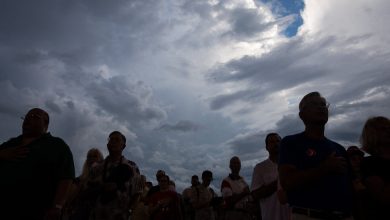Menachem Daum, Filmmaker Who Explored the World of Hasidim, Dies at 77

Menachem Daum, a filmmaker who co-produced a groundbreaking 1997 documentary that illuminated the cloistered world of America’s Hasidim, died on Jan. 7 in a hospital near his home in Borough Park, Brooklyn. He was 77.
His death was confirmed by Eva Fogelman, a friend and the author of a book about Christian rescuers of Jews during the Holocaust. She said Mr. Daum had been treated for congestive heart failure.
What made the documentary, “A Life Apart: Hasidism in America,” so striking was Mr. Daum’s ability to get people who scorn movies and television sets to sit on camera for revealing interviews, allowing him to chronicle their mores and rituals. The resulting film offered a complex portrait of a religious group usually depicted as somber and impenetrable.
That achievement was not a given. Mr. Daum, though ultra-Orthodox, was not Hasidic himself. And although he had earlier made a film about caregivers for the aged, he was scarcely a seasoned filmmaker.
But he was well versed in the Torah, the Talmud and the intricacies of Orthodox Jewish observance. He spoke Yiddish — the Hasidic lingua franca — and lived in a Hasidic neighborhood. He teamed with an experienced filmmaker, Oren Rudavsky, the son of a Reform rabbi, to produce and direct a documentary that presented a complex portrait of a religious group usually depicted as somber and impenetrable — for example, it included scenes of Hasidim joyfully dancing.
The Hasidic movement was founded in the 18th century in Eastern Europe by a rabbi known as the Baal Shem Tov, who felt that Judaism had overemphasized intellectual qualities to the detriment of spiritual fervor and sincerity.
Mr. Rudavsky said in an interview that he believed “A Life Apart” was the first feature-length documentary released in American theaters that explored Hasidism.
The film, narrated by Leonard Nimoy and Sarah Jessica Parker, premiered at the Walter Reade Theater in Manhattan and in Los Angeles. It later ran for five months at the Quad Cinema in Manhattan and was shown on PBS television.
“‘A Life Apart’ enlivens its history and analysis with surprisingly tender family scenes, with evocations of the Hasidic world’s deep mysticism, and with some of the community’s most colorfully quaint features, like formal matchmaking,” Janet Maslin wrote in her review in The New York Times.
Mr. Daum’s friendships and his familiarity with his neighborhood were the key to unlocking the reclusive Hasidic world, whose members deliberately wall themselves off socially from the secular world to avoid its temptations and to sustain their way of life, spurning even college educations and schooling in the professions.
“If I put on a hat, I look like I belong even more than I do,” Mr. Daum told The Times before the film’s premiere. “I could assure them that this film would not mock or exploit them.”
The film was not a work of puffery; it also offered critical perspectives. A Hasidic woman laments what she sees as her second-class status, and a Black parks employee in Brooklyn condemns what he says is the aloofness and “spiritual arrogance” of the Hasidim he has encountered.
Annette Insdorf, a professor of film at Columbia University, said in an email that “A Life Apart” “provided a riveting introduction to the history of Hasidic life, as well as its enduring vibrancy.”
The film, she added, “opened my eyes to the Hasidic sense that all things can be sacred — including sex — with an emphasis on prayer, joy and community.”
In his second film with Mr. Rudavsky, “Hiding and Seeking: Faith and Tolerance After the Holocaust” (2004), Mr. Daum tried to leaven his two grown sons’ scorn for non-Jews. Accompanied by a camera crew, he took them to Poland to meet the family of the Roman Catholic couple who had saved the life of their maternal grandfather, Chaim Federman, during the Holocaust by hiding him and his two brothers in a dugout beneath piles of hay in a barn. The encounter with Honorata Matuszezyk Mucha — who had risked her life, as had her parents, to shelter and feed the three brothers — left the Daum family visibly moved.
The film’s final scenes show the Daums successfully arranging for the Muchas to be honored as “the righteous among the nations” at the Yad Vashem Holocaust memorial in Jerusalem. The initially skeptical elder son, Tzvi Dovid, enthusiastically announces to the clan that his family has set up a scholarship fund for the Mucha grandchildren. But Mr. Daum’s younger son, Akiva, while admitting that he “learned there’s some very good people in the world,” maintains that the Muchas and Mrs. Mucha’s parents were “exceptions to the rule.”
“The general rule of thumb was, to get rid of the Jew is the best thing to do,” he says, “and they’d probably do it again.”
Dr. Insdorf said “Hiding and Seeking” demonstrated that Mr. Daum was “a humanist for whom documentaries are not merely personal chronicles, but a means to repair the world.”
Menachem Daum was born on Oct. 5, 1946, in a displaced persons camp in the Bavarian town of Landsberg am Lech in what was then Allied-occupied Germany. Both his refugee parents, Moshe Yosef Daum and Fela (Nussbaum) Daum, had survived German concentration camps, but they each lost a spouse and a son, as well as countless other relatives. They married in the camp, and when they had a son, they named him Menachem, which means comforter or consoler in Hebrew.
“Apparently, they hoped I might be able to restore some happiness in their lives,” Mr. Daum told Religion and Ethics Newsweekly in a 2001 interview.
His mother, though observant, remained angry at God for standing by indifferently as her infant son Avrohom was torn from her arms when she arrived at Auschwitz. Her husband, who belonged to the Ger sect of Hasidim, decided that humans cannot understand God’s ways and that questions about God’s culpability had no answers, Mr. Daum said in “Hiding and Seeking.”
The family immigrated to the United States in 1951 and was settled by HIAS (originally the Hebrew Immigrant Aid Society) in Schenectady, N.Y., where Menachem fleetingly took the American name Martin. When he asked if he could patch together a Halloween costume, his father became concerned about the Gentile influences on him in a city that lacked yeshivas and moved the family to Borough Park. It was a neighborhood that was absorbing many of the remnants of Europe’s once-teeming Hasidic sects, who eventually came to be the neighborhood’s most populous group.
Menachem attended local yeshivas and, after high school, spent four years in advanced Talmud study. But he realized that the life of a Talmudic scholar was not for him, and he started evening classes at Brooklyn College.
“I had been led to believe that there was little of value to be learned from outsiders,” he says in “Hiding and Seeking.” “I discovered this to be untrue. The people I met struck me as extremely ethical, and almost religious in their efforts to make the world a better place.”
In 1978, he received a doctorate in educational psychology from Fordham University. His dissertation was on aging, and for the next 25 years he worked as a research gerontologist for New York City’s Department of Aging and the Brookdale Center on Aging at Hunter College.
According to Ms. Fogelman, when Mr. Daum had to care for his mother after she was diagnosed with Alzheimer’s disease, he discovered that there were 35 million Americans caring for older people. Intrigued by the visual power of filmmaking, he made his first documentary, “In Care of: Families and Their Elders.”
Beguiled by the medium, he decided to make a second film, on the tenacity of faith among Holocaust survivors. He sought out Mr. Rudavsky as a collaborator, and their conversations led to a focus on the Hasidic community.
To support his family while making his specialized films, Mr. Daum often shot videos of weddings and bar mitzvahs.
In addition to his two sons, Mr. Daum is survived by his wife, Rifka (Federman) Daum; a daughter, Chaya Schron; a brother, Rabbi Heshy Daum; a sister, Beverly Berkowitz; and grandchildren.
At the end of “Hiding and Seeking,” Mr. Daum observes: “There used to be a Jewish tradition called a Tsava. When you reached a certain stage in your life and you realized you weren’t going to be around forever to guide your children, you would take the most important values that you wanted them to live by and you would commit them to a document, sort of like an ethical will. I hope that the trip I took my sons to Poland on, in a way, I hope they see that as my Tsava to them.”



